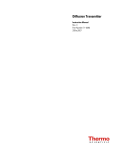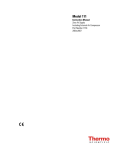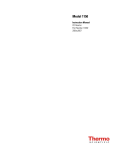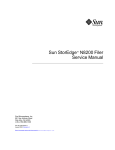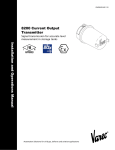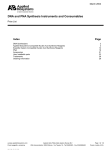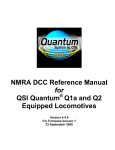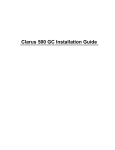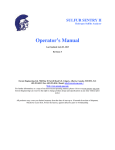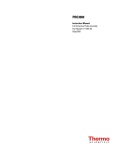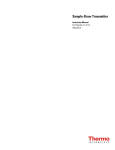Download Model 200L
Transcript
Model 200L Instruction Manual Dual Dilution Probe Controller Part Number 14638 20Dec2007 © 2007 Thermo Fisher Scientific Inc. All rights reserved. Specifications, terms and pricing are subject to change. Not all products are available in all countries. Please consult your local sales representative for details. Thermo Fisher Scientific Air Quality Instruments 27 Forge Parkway Franklin, MA 02038 1-508-520-0430 www.thermo.com/aqi WEEE Compliance This product is required to comply with the European Union’s Waste Electrical & Electronic Equipment (WEEE) Directive 2002/96/EC. It is marked with the following symbol: Thermo Fisher Scientific has contracted with one or more recycling/disposal companies in each EU Member State, and this product should be disposed of or recycled through them. Further information on Thermo Fisher Scientific’s compliance with these Directives, the recyclers in your country, and information on Thermo Fisher Scientific products which may assist the detection of substances subject to the RoHS Directive are available at: www.thermo.com/WEEERoHS. Thermo Fisher Scientific WEEE Compliance TABLE OF CONTENTS CHAPTER 1 INTRODUCTION ..........................................................................1-1 Principle of Operation...................................................................................................... 1-1 Specification ...........................................................................................................1-2 CHAPTER 2 INSTALLATION............................................................................... 2-1 Unpacking ........................................................................................................................ 2-1 Installation Procedure ..................................................................................................... 2-2 System Plumbing Connections ........................................................................................ 2-2 Startup Procedure............................................................................................................. 2-3 CHAPTER 3 OPERATION ................................................................................3-1 Electronics........................................................................................................................ 3-1 Relay Board.......................................................................................................... 3-2 Switch Board........................................................................................................ 3-3 Rear Terminal Board............................................................................................ 3-4 Gauges ....................................................................................................................3-6 Flow Description.............................................................................................................. 3-7 Subassemblies ................................................................................................................. 3-8 CHAPTER 4 CALIBRATION ...................................................................................... 4-1 Equipment Required ........................................................................................................ 4-1 NOx Concentration Standard .....................................................................................................4-1 Dilution Probe ................................................................................................................. 4-1 Dilution Probe Technique ............................................................................................... 4-2 Dual Dilution Configuration ............................................................................................ 4-3 Dilution Calculations...................................................................................................4-4 CHAPTER 5 PREVENTIVE MAINTENANCE....................................................5-1 Safety Precautions............................................................................................................ 5-1 Replacement Parts List..................................................................................................... 5-2 Relay Board Replacement................................................................................................ 5-3 Switch Board Replacement.............................................................................................. 5-4 No. 8 Valve Assembly ..................................................................................................... 5-5 iii No. 12 Valve Assembly ................................................................................................... 5-6 No. 13 Valve Assembly ................................................................................................... 5-7 Precision Orifice Check ................................................................................................... 5-8 Span Solenoid Valve Check............................................................................................. 5-9 Flow Leak Check ............................................................................................................. 5-9 Spare Parts ..................................................................................................................... 5-10 Service Locations........................................................................................................... 5-11 CHAPTER 6 TROUBLESHOOTING .................................................................6-1 Troubleshooting Guide .................................................................................................... 6-1 APPENDIX A WARRANTY............................................................................... A-1 APPENDIX B SCHEMATICS ..................................................................... B-1 LV200 AC Wiring Schematic..........................................................................................B-1 Main Control & Relay Board...........................................................................................B-2 200L Switch Board (Dual and Single) .............................................................................B-3 Terminal Board ................................................................................................................B-4 iv LIST OF ILLUSTRATIONS Figure Page 2-1. Front Panel................................................................................................................ 2-1 2-2. Model 200L Dual Probe Controller Rear Panel ....................................................... 2-3 2-3. Typical Dual Probe Controller System Line Connections........................................ 2-4 2-4. Dilution Probe .....................................................................................................2-5 3-1. Relay Board Assembly ............................................................................................. 3-2 3-2. Switch Board Assembly ........................................................................................... 3-3 3-3. Rear Terminal Board ................................................................................................ 3-4 3-4. Rear Terminal Status and Remote Activation .......................................................... 3-5 3-5. Gauge Locations ....................................................................................................... 3-6 3-6. Dual Probe Controller Plumbing Diagram ............................................................... 3-7 3-7. Case Bottom Assembly Layout ................................................................................ 3-8 4-1. Sonic Orifice Assembly............................................................................................ 4-3 4-2. Typical Dual Probe Controller Line Connections .................................................... 4-4 5-1. Relay Board Assembly ............................................................................................. 5-3 5-2. Switch Board Assembly ........................................................................................... 5-4 5-3. No. 8 Valve Assembly.............................................................................................. 5-5 5-4. No. 12 Valve Assembly............................................................................................ 5-6 5-5. No. 13 Valve Assembly............................................................................................ 5-7 5-6. Rear Panel Assembly................................................................................................ 5-8 5-7. Span Valve Manifold Assembly............................................................................... 5-9 v LIST OF TABLES Table Page 4-1. Sonic Orifice Sizes ................................................................................................... 4-5 5-1. Replacement Parts .................................................................................................... 5-2 5-2. Recommended Spare Parts ..................................................................................... 5-10 vii CHAPTER 1 INTRODUCTION Thermo Environmental Instruments is pleased to provide this Model 200L Dual Dilution Probe Controller. We are committed to the manufacture of instrumentation exhibiting high standards of quality, performance, and workmanship. TEI service and support personnel are available to provide assistance with any questions or problems that may arise in the use of this controller. The Model 200L Dual Dilution Probe Controller provides a flexible solution for your continuous monitoring needs. With an external source of high-pressure air and calibration gas, the dilution controller provides the means of delivering precisely diluted samples from two dilution probes. The Model 200L is based on the engineering design and selection of components having complementary specifications which result in a simple to operate, easy to adapt, high accuracy, and low maintenance instrument. PRINCIPLE OF OPERATION The Model 200L can be utilized in conjunction with various dilution probe configurations. The Model 200L is designed to control the conditioning of stack effluents by mixing the exhaust gases with pressurized regulated zero air at a known ratio in the dilution probe. This method meets the requirements for emission source monitoring as required in 40 CFR 60 and 40 CFR 75. The stack gas is extracted continuously via filters and a critical orifice by an eductor section inside the dilution probe. The main air stream (pressurized air) with an adjustable flow of Q1 litres/min. creates a vacuum in the space between the primary and secondary nozzle of the ejector pump. This vacuum is used to extract the stack gas via the critical orifice mounted inside the dilution probe. The critical orifice defines the stack sample flow at a value of Q2 litres per minute (indicated on the glass body of the critical orifice). The flow Q2 will be reached when the vacuum in the probe exceeds approximately 10” Hg. As the value of the dilution air pressure may be adjusted by the operator, the dilution ratio can be varied between certain limits. The critical orifice selection determines which dilution setting is achieved. Ratios of 50:1, 100:1, 150:1 and 200:1 are the most commonly used configurations for combustion source emission monitoring. The controller allows the user to set the dilution ratio of the probe. Solid state electronics permit the control of calibration gas selection and two separate probes. Front panel rotary switches are used to select the calibration gases or sample probes manually. The Model 200L can be controlled externally by another instrument, programmable logic controller or data acquisition system. The dilution ratio is calculated to decrease the water moisture in the sample gas to a level at which the diluted sample moisture remains in the vapor state. The use of dry instrument air and dilution ratios on the order of 100:1 results in a sample that is 99% clean dry air. This is an excellent sample for analysis with ambient air analyzers. High accuracy and freedom from interference is assured. 1-1 Chapter 1 Introduction SPECIFICATIONS Operating Temperature 60 to 100 oF in NEMA 1 Enclosure -25 to 125 oF in optional NEMA 4 or 12 Enclosures Power Requirements 115/230 Volts ±10%, single -phase, 50/60 Hz, 200 Watts Remote Inputs Ability to Control Zero, Sample, and 5 Span Ports. Output Contacts Zero, Sample, Sample Probe Selected and 5 spans. Physical Dimensions 17” W x 8 ¾” H x 23" Weight 38 lbs. 1-2 CHAPTER 2 INSTALLATION Installation of the Model 200L includes: unpacking the controller, connecting a sample probe, connecting zero air and calibration gas lines to the controller. UNPACKING The Model 200L is shipped complete in one container. If, upon receipt of the controller, there is obvious damage to the shipping container, notify the carrier immediately and hold for inspection. The carrier, and not Thermo Environmental Instruments Inc., is responsible for any damage incurred during shipment. Follow the procedure below to unpack and inspect the controller. Figure 2-1: Front Panel 1. Remove the controller from the shipping container and set it on a table or bench that allows easy access to both the front and rear of the instrument. 2. Remove the controller cover to expose the internal components. 3. Remove any internal packing material. 4. Check for possible damage during shipment 5. Check all connectors and printed circuit boards to see if they are firmly attached. 6. Re-install the controller cover. 2-1 Chapter 2 Installation INSTALLATION PROCEDURE Before making any connections to the rear of the control unit, refer to system documentation, if supplied, for any details that may not be included in this manual. Check the Purchase Order packing slip to ensure the unit was ordered in the correct configuration. If any of the information is incorrect, contact your local Sales Representative or call a Sales Representative at Thermo Environmental Instruments. Before powering up the Model 200L Dual Dilution Probe Controller, make sure the transformer configuration is correct for the power available. SYSTEM PLUMBING CONNECTIONS Connecting the various lines to the rear panel of the Model 200L is illustrated in Figure 2-3. If the unit was purchased with a system, please refer to the appropriate documentation for proper connections. All tubing connected to the controller should be made of Teflon. With proper configuration complete and checked, the startup procedure can be performed. 2-2 Chapter 2 Installation 62P734 Figure 2-2: Model 200L Dual Rear Panel STARTUP PROCEDURE 1. Connect the power cord to the rear of the unit and turn the power ON. 2. Check to make sure the power switch light is ON. 3. Rotate each selector switch through its various positions to check that all the LED’s turn ON properly. 4. While moving the switch, listen for the solenoid valves clicking into position while observing the LED’s turn ON. Figure 2-3 illustrates a common connection to a rack system for a Dual Dilution Probe Controller. Eight plumbing connections are critical to the operation of the Model 200L. A set of four lines from each of the two dilution probesprobes. The four lines from each probe are as follows: 1. 2. 3. 4. Dilution Air (DA, DA2) Diluted Sample (DS, DS2) Vacuum Line (VL1, VL2) Calibration Line (CL1, CL2) 2-3 Chapter 2 Installation Figure 2-3: Typical Dual Probe Controller System Tubing Connections The connection lines from the Dilution Controller Unit to the Dilution Sample Probe should be properly labeled and connected to the correct port fitting. A pressure of 80 to 100 PSIG of clean zero air is supplied to the Air Inlet Port. The Air Inlet is then reduced to a pressure of approximately 40 PSIG by an internal regulator which is adjusted for the appropriate dilution ratio (100:1 for example). (The selected dilution ratio is determined by the customer’s application data sheet.). Figure 2-4 shows a common stack probe installation. 2-4 Chapter 2 Installation Figure 2-4: Dilution Probe 2-5 CHAPTER 3 OPERATION In order to fully understand the operation of the Model 200L, a general knowledge of the electronics, flow, and subassemblies is recommended. A better understanding of the components themselves will allow the user to more efficiently change parts or subassemblies. ELECTRONICS The Relay and Switch boards are the primary active electronic components mounted in the Controller. Positive 24 Volts DC from the Relay Board activates the solenoid valves. The position of the selector switch determines which solenoid valve or valves are activated in order to allow air or gas flow through the Model 200L Dilution Controller. The rear terminal board delivers dry contact status outputs which can be connected to a data acquisition unit. The controller can be activated remotely by a data logger or similar device. 3-1 Chapter 3 Operation Figure 3-1. Relay Board Assembly RELAY BOARD The relay board supplies +24 Volts to the solenoid valves, depending upon the position of the switch. The Relay Board is part of the Regulator-Relay Board Assembly. Three ribbon cables are attached to the relay board. One of the cable assemblies is connected to the switch board assembly and the other two are connected to the rear terminal board. The relay board controls the position of the valves and provides solid state contacts to the rear connector board. See appendix B for Relay Board schematic. The +24 Volts DC goes through the relay board and is delivered to the Switch Board Assembly. The switch from the Switch Board Assembly delivers the +24 Volts DC to the appropriate solid state relay. A ¼ Amp fuse is used for safety prevention of surge current while the unit is in the sample mode. 3-2 Chapter 3 Operation Figure 3-2. Switch Board Assembly SWITCH BOARD A rotary switch selects the Mechanical Relays on the Relay Board Assembly. The Rotary switch uses indented stops to select from zero, sample, and 5 span valves. A total of 13 LED’s are seated on the front panel. The three LED’s aligned horizontally at the bottom are not used for the dual probe configuration. The LED’s will only be used in the dual probe controller unit. 3-3 Chapter 3 Operation Figure 3-3. Rear Terminal Board REAR TERMINAL BOARD The Rear Terminal Board provides status contacts for zero, sample, and 5 span valves. A constant +24 Volts DC is present at the Rear Terminal Board for remote activation by a data acquisition system or relay contact configuration. In order to activate for zero, sample or the 5 span valves, +24 Volts DC is delivered to the appropriate terminal connection from a dry contact closed state. All valves are in the de-energized state, meaning that both lines to the solenoid valve are at a zero volt potential. 3-4 Chapter 3 Operation Figure 3-4. Rear Terminal Status and Remote Activation * NU, indicates Not Used. * NO, indicates Normally Open. Two ribbon cables are connected from the rear terminal board to the relay board assembly. J9 from the Relay Board provides the status contacts for zero air and one to five span gas valves. The connections for the status and remote activation are illustrated in Figure 3-4 3-5 Chapter 3 Operation The dual probe controller has additional valves to control the indication of the probe vacuum and dilution air pressure gauges and to select the source of dilute sample gas. A voltage of 24 Volts switches the valves from common to either normally OPEN or normally CLOSED. With no potential across the valve, then the path of the valve would go from common to normally OPEN (NO). With a potential of 24 Volts across the two leads of the valve, then the flow through of the valve would be from common to normally CLOSED (NC). Refer to flow diagram Figure 3-6. In a de-energized state, the indications and sample selected will be from dilution probe one. Figure 3-5. Gauge Locations GAUGES Three gauges are affixed to the front panel of the Model 200L, probe vacuum, dilution air pressure, and zero air. Figure 3-5 illustrates the location for the gauges. The dilution air pressure should be set to approximately 40 PSIG to obtain a sample dilution rate of 100:1 (with a 50 ml/min orifice). If this pressure is below 30 PSIG, then a leak check should be performed. Refer to the Troubleshooting section for leak checking the Model 200L. The vacuum gauge indication corresponds to the vacuum applied to the orifice in the dilution probe. 3-6 Chapter 3 Operation FLOW DESCRIPTION Figure 3-6 illustrates the Model 200L plumbing diagram in detail. Figure 3-6 is a flow diagram for a dual probe configuration with sample switching, i.e., two sample points and only one set of instruments. 62P817 Figure 3-6. Dual Plumbing Diagram 3-7 Chapter 3 Operation SUBASSEMBLIES The following subassemblies are available from Thermo Environmental Spare Parts Department. With subassemblies, it is easier to replace components or troubleshoot in an efficient manner. Figure 3-7. Case Bottom Assembly Layout 3-8 CHAPTER 4 CALIBRATION PERFORMANCE This chapter describes the procedure for performing the multipoint calibration using the TEI Model 42C as an example. The information described here should be sufficient to perform a calibration check. EQUIPMENT REQUIRED NOx Concentration Standard A Model 42C instrument to be used as reference analyzer. A cylinder of NO in N2 containing an appropriate concentration of NO for the selected operating range of the analyzer under calibration is necessary. The assay of the cylinder should be traceable either to a National Institute of Standards and Technology (NIST) Air Standard Reference Material (SRM) or an NIST/EPA approved gas manufacturer’s Certified Reference Material (CRM). A recommended protocol for certifying NOx gas cylinders against a NOx, SRM or CRM is given in the USEPA. The NOx gas cylinder should be recertified on a regular basis determined by the local quality control program. DILUTION PROBE Each dilution probe requires four lines to be connected to the probe controller. The lines are listed as the Dilution Air, Calibration Line, Diluted Sample, and Vacuum Line. The Dilution Air is the high-pressure air being supplied to the probe. The probe utilizes this pressurized air for extracting and diluting the sample, calibration zero, or gas from the sonic orifice. The Calibration Line is used to deliver either Zero Air or Span 1 to 5 gases. The dilution controller directs the flow of the Zero Air or the Span Gas through the Calibration Line to the probe. 4-1 CHAPTER 4 CALIBRATION PERFORMANCE DILUTION PROBE TECHNIQUE Dilution probe technology may be generically defined as a sampling technique whereby a small continuous sample is filtered and diluted at stack temperature prior to transport to a set of analyzers. A preferred way to do this is with an in-stack venturi, in which preheated instrument air serves the triple function of extracting the sample, dilution, and transporting it under pressure to the remote analyzers. Figure 4-2 shows a typical system configuration. Advantages of the technique, as contrasted to more conventional extractive systems, include: 1. Long filter life due to a very low sampling rate. 2. Elimination of heated probe and sample lines by lowering the dew point below the coldest expected ambient temperature. 3. Elimination of all valving and electric utilities at the probe location. 4. Fail-safe sampling whereby analyzers are intrinsically protected from any condensates or other matter from the source which could harm the sample system or instrument. 5. All parts of the systems can be checked using calibration gases. 6. Conventional ambient-level analyzers (which may already be in use at the site) are used, reducing training time for operators and utilizing existing spare part supplies 4-2 CHAPTER 4 CALIBRATION PERFORMANCE Figure 4-1. Sonic Orifice Assembly DUAL DILUTION CONFIGURATION Before any calibrations or testing is to be done to the Dilution Controller and the Sonic Orifice Probe, the line connections from the Model 200L to the Sonic Orifice Probe should be properly connected and verified. Refer to figure 4-2 for a typical dual probe controller connection. 4-3 CHAPTER 4 CALIBRATION PERFORMANCE Figure 4-2. Typical Dual Probe Controller Line Connections DILUTION CALCULATIONS Calculations are performed in conjunction with a gas analyzer or rack of no more than five analyzers. It is very important to be sure the information pertaining to the critical orifice used in the dilution probe is accurate. If the orifice in the dilution probe is in question, then the probe should be inspected for the proper sonic orifice. Refer to Table 4-1 for specific data on each critical orifice. 4-4 CHAPTER 4 CALIBRATION PERFORMANCE Table 4-1 Critical Orifice Sizes 20 Mil 50 Mil 100 Mil 200 Mil P/N P/N P/N P/N 200:1 100:1 50:1 20:1 If the appropriate critical orifice is determined, then the Model 200L can be adjusted. Connect the analyzer to the Model 200L and allow the gas to flow through the dilution probe by setting the Dilution Controller for the appropriate Span Gas. If the Concentration of the test bottle is connected to Span 1 port, then turn the selector switch to Span 1 position. If a dilution ratio of 100:1 has been established, then the concentration of the expected value can be determined. Take the concentration value of the bottle and divide it by the ratio. For example, if the value of the bottle for NOx is 500 PPM, then the reading on the instrument should be within 4% of 5 PPM. The concentration should be between 4.80 to 5.20 PPM. If the result of the reading is not within 4%, then either the instrument being used is not calibrated properly or the Dilution Controller needs to be adjusted for the appropriate value. The dilution air is adjusted to mix the right amount of air with the gas in order to achieve the correct dilution ratio. Adjusting the dilution air regulator clock-wise will introduce more air to the probe, thus increasing the dilution ratio and reducing the instrument reading. Adjusting the dilution air regulator counter-clock-wise will reduce the amount of air introduced to the probe, thus decreasing the dilution ratio and increasing the instrument reading. Before adjusting the dilution air regulator each time, wait for the flow of the air and gas to settle to a stable reading. This can take several minutes if long sample lines are in use. The dilution ratio may swing in either direction from the previous adjustments before actually stabilizing. Care should be taken when adjusting the dilution air regulator. It is better to adjust the dilution air regulator with onequarter turns for adjustments, especially if the readings are close (within the 4%) of the expected value of the dilution ratio. Once the right amount of dilution air to the probe has been achieved, then the dilution air regulator should be left alone. Tighten the locking nut of the dilution air regulator to keep the adjustment from changing. The controller should not have to be readjusted unless maintenance is performed on the instrument or sample system. 4-5 CHAPTER 5 PREVENTIVE MAINTENANCE This chapter describes the periodic maintenance procedures that should be performed on the Model 200L to ensure proper, uninterrupted operation. Components have a limited life expectancy, so periodic check or replacement of certain components or devices is necessary. Precision Orifices and Gauges are a few components that should be properly checked for continuous operations. This chapter also explains how to replace the Model 200L subassemblies. It is recommended for the individual to be familiar with the subassemblies before attempting to disassemble or repair the controller unit. SAFETY PRECAUTIONS Some internal components may be damaged by the discharge of static electricity. To avoid damaging internal components, follow these precautions when performing any service procedure: CAUTION: Wear an antistatic wrist strap that is properly connected to earth ground (note that when the analyzer is unplugged, the chassis is not at earth ground). If an antistatic wrist strap is not available, be sure to touch a grounded metal object before touching any internal components. Carefully observe the instructions in each procedure. Remove the power cord from the unit when any of the assemblies are to be replaced. 5-1 Chapter 5 Preventive Maintenance REPLACEMENT PARTS LIST Table 5-1 lists the part numbers of the major subassemblies in the Model 200L. Refer to Figure 3-7 to identify their locations. Table 5-1. Replacement Parts Part number Description 10546 Span Solenoid Valve 5 7368 Solenoid Valve 3-Way(No. 8,12,13) 1 10539 Precision Orifice 1 6984 Dilution Air Regulator 1 4546 Vacuum Gauge 30 in of HG 1 8105 Pressure Gauge 30 PSIG 1 4495 Flow Meter 2.5 LPM 2 5-2 Quantity Chapter 5 Preventive Maintenance RELAY BOARD REPLACEMENT Equipment required: New Relay Board Assy. (Part No. 14672) Nut Driver or Adjustable Wrench Flat Tip Screwdriver Slide the unit from the rack cabinet, so the cover can be taken off. Remove the four screws that hold the cover above the unit. The Relay Board and Switch Board assemblies should now be accessible. Remove the unit and locate the Relay Board Assembly. Remove the two screws holding down the Relay Board bracket. Remove any cables, connectors and lines that will prevent the bracket from moving. Remove the fitting lines to the regulator. Once the assembly is removed from the case, then the five screws can be removed from the relay board. Replace the relay board with the new board and secure the board with the five screws that held the old relay board. Install the assembly in the reverse order in which it was removed. Connect the appropriate connectors to the numbered locations on the relay board. Apply power to the unit and make sure the Relay Board is working properly by switching all the selection points. Figure 5-1. Relay Board Assembly 5-3 Chapter 5 Preventive Maintenance SWITCH BOARD REPLACEMENT Equipment required: New Switch Board Assy. (Part No.14669) Nut Driver or Adjustable Wrench Flat Tip Screwdriver Slide the unit from the rack cabinet so the cover can be taken off and the Switch Board Assemblies are accessible. Remove the four screws that hold the cover above the unit. Remove the unit and locate the Switch Board Assembly. Remove the selector knob from the front of the unit which is secured with two allen set screws. With an adjustable wrench, remove the nut from the switch. Remove the screw from inside the controller unit that holds the bottom of the Switch Board Assembly. Remove any connector or wiring to the switch board and then remove the assembly from the case. Replace the assembly in the reverse order in which the assembly was removed. Reconnect any cables and wiring to the switch board. Apply power to the unit and make sure the Switch Board is work properly by switching all the selection points. Figure 5-2. Switch Board Assembly 5-4 Chapter 5 Preventive Maintenance NO. 8 VALVE ASSEMBLY The valve assembly is used in the dual controller to switch between the two probes. The valves are numbered to distinguish the difference of the valves. Each numbered valve provides different functions in the dilution controller unit. No. 8 valve allows the stream of the measured sample flow to the instruments. Figure 5-3. No. 8 Valve Assembly 5-5 Chapter 5 Preventive Maintenance NO. 12 VALVE ASSEMBLY This valve is used to switch the lines for the vacuum read of the probes. If the unit is in stream 1 then valve 12 will switch to monitor the vacuum from measured probe. Figure 5-4. No. 12 Valve Assembly 5-6 Chapter 5 Preventive Maintenance NO. 13 VALVE ASSEMBLY No. 13 valve allows the flow of the Dilution Air to the Dilution Air pressure gauge. Both probes are supplied with dilution air from the same High Pressure Air being delivered to the dilution controller. Figure 5-5. No. 13 Valve Assembly 5-7 Chapter 5 Preventive Maintenance PRECISION ORIFICE CHECK The precision orifice is to allow a certain amount of flow for the zero and span gas to the dilution probe. The flow must be enough so the total flow of all the analyzers in the system draws from the probe. A flow of approximately 4 to 5 LPM is drawn from the dilution probe. Item 2 in Figure 5-7 is the assembly for the precision orifice. Figure 5-6. Rear Panel Assembly 5-8 Chapter 5 Preventive Maintenance SPAN SOLENOID VALVE CHECK The valves can be checked by using air flow applied to the common port of the valve. Use the plumbing diagram associated with the type of controller supplied. Figure 5-7. Span Valve Manifold Assembly FLOW LEAK CHECK This procedure is to enable the user to thoroughly check the unit for leaks. Leak checking would only be conducted if the Model 200L is suspected of performance calibration errors. Leak checking the Model 200L is to insure the unit from erroneous readings from the controller to the dilution probe. A leak check is performed at the factory to ensure the proper operations 5-9 Chapter 5 Preventive Maintenance before shipping to the customer. Most leak checks would be performed when there is an apparent linearity or drift problem with the system. Before checking the leaks in the controller, it is good practice to leak check the lines to the Sonic Orifice Probe. Disconnect the line to the dilution controller and the Sonic Orifice Probe. Attach a pressure gauge to the end of the line that was attached to the probe. Connect a shut off valve and pressure gauge to the end of the line that was connected to the controller. Apply approximately 50 PSIG of pressure through the line and then shut off the valve to keep the pressure suspended in the line. Wait for about 2 minutes and monitor the pressure reading to see if the reading of the pressure drops. If the valve was shut off at 50 PSIG and stays at 48 PSIG for 2 minutes, than it is safe to say the line is well leak tight. If the pressure goes below and gradually falls to zero, the line either needs to be replaced or the fittings are not tight. All four lines to the probe should be checked in this matter before checking the controller for leaks. Leak checking the controller requires the zero air and a bottle of leak detection solution, TEI Part No. 5770. Cap off any potential ports that will allow pressured air to escape, for example the instrument air out. Pressurize the unit with 50 PSIG and monitor for any leaks with the leak detection solution at all the fittings. The dilution air regulator has a bleeder valve, so a flow sound is normal. If the leak detection solution bubbles at any fittings points, then replace the fitting. Once the Model 200L is leak checked and repaired as necessary, the controller can be put back into service. SPARE PARTS The following list is a recommended spare parts list. The material below is recommended to keep on-site for quick repair in case of unexpected failures. Table 5-2 lists the recommended spare parts. Table 5-2. Spare Parts Part Number Description 10546 7368 10539 7916 11238 Span Solenoid Valve Solenoid Valve 24Volt 3-Way Precision Orifice Fuse ¼ Amp 250 Volts Main Fuses 2 Amps Quantity 1 1 1 1 2 Keeping spare parts on hand will reduce the amount of time it takes to complete a repair. 5-10 Chapter 5 Preventive Maintenance SERVICE LOCATIONS For additional assistance, Environmental Instruments Division has service available from exclusive distributors worldwide. Contact one of the phone numbers below for product support and technical information. 866-282-0430 Toll Free 508-520-0430 International 5-11 Appendix A Warranty Seller warrants that the Products will operate or perform substantially in conformance with Seller's published specifications and be free from defects in material and workmanship, when subjected to normal, proper and intended usage by properly trained personnel, for the period of time set forth in the product documentation, published specifications or package inserts. If a period of time is not specified in Seller’s product documentation, published specifications or package inserts, the warranty period shall be one (1) year from the date of shipment to Buyer for equipment and ninety (90) days for all other products (the "Warranty Period"). Seller agrees during the Warranty Period, to repair or replace, at Seller's option, defective Products so as to cause the same to operate in substantial conformance with said published specifications; provided that (a) Buyer shall promptly notify Seller in writing upon the discovery of any defect, which notice shall include the product model and serial number (if applicable) and details of the warranty claim; (b) after Seller’s review, Seller will provide Buyer with service data and/or a Return Material Authorization (“RMA”), which may include biohazard decontamination procedures and other product-specific handling instructions; and (c) then, if applicable, Buyer may return the defective Products to Seller with all costs prepaid by Buyer. Replacement parts may be new or refurbished, at the election of Seller. All replaced parts shall become the property of Seller. Shipment to Buyer of repaired or replacement Products shall be made in accordance with the Delivery provisions of the Seller’s Terms and Conditions of Sale. Consumables, including but not limited to lamps, fuses, batteries, bulbs and other such expendable items, are expressly excluded from the warranty under this warranty. Notwithstanding the foregoing, Products supplied by Seller that are obtained by Seller from an original manufacturer or third party supplier are not warranted by Seller, but Seller agrees to assign to Buyer any warranty rights in such Product that Seller may have from the original manufacturer or third party supplier, to the extent such assignment is allowed by such original manufacturer or third party supplier. In no event shall Seller have any obligation to make repairs, replacements or corrections required, in whole or in part, as the result of (i) normal wear and tear, (ii) accident, disaster or event of force majeure, (iii) misuse, fault or negligence of or by Buyer, (iv) use of the Products in a manner for which Thermo Fisher Scientific Warranty A-1 they were not designed, (v) causes external to the Products such as, but not limited to, power failure or electrical power surges, (vi) improper storage and handling of the Products or (vii) use of the Products in combination with equipment or software not supplied by Seller. If Seller determines that Products for which Buyer has requested warranty services are not covered by the warranty hereunder, Buyer shall pay or reimburse Seller for all costs of investigating and responding to such request at Seller's then prevailing time and materials rates. If Seller provides repair services or replacement parts that are not covered by the warranty provided in this warranty, Buyer shall pay Seller therefor at Seller's then prevailing time and materials rates. ANY INSTALLATION, MAINTENANCE, REPAIR, SERVICE, RELOCATION OR ALTERATION TO OR OF, OR OTHER TAMPERING WITH, THE PRODUCTS PERFORMED BY ANY PERSON OR ENTITY OTHER THAN SELLER WITHOUT SELLER'S PRIOR WRITTEN APPROVAL, OR ANY USE OF REPLACEMENT PARTS NOT SUPPLIED BY SELLER, SHALL IMMEDIATELY VOID AND CANCEL ALL WARRANTIES WITH RESPECT TO THE AFFECTED PRODUCTS. THE OBLIGATIONS CREATED BY THIS WARRANTY STATEMENT TO REPAIR OR REPLACE A DEFECTIVE PRODUCT SHALL BE THE SOLE REMEDY OF BUYER IN THE EVENT OF A DEFECTIVE PRODUCT. EXCEPT AS EXPRESSLY PROVIDED IN THIS WARRANTY STATEMENT, SELLER DISCLAIMS ALL OTHER WARRANTIES, WHETHER EXPRESS OR IMPLIED, ORAL OR WRITTEN, WITH RESPECT TO THE PRODUCTS, INCLUDING WITHOUT LIMITATION ALL IMPLIED WARRANTIES OF MERCHANTABILITY OR FITNESS FOR ANY PARTICULAR PURPOSE. SELLER DOES NOT WARRANT THAT THE PRODUCTS ARE ERROR-FREE OR WILL ACCOMPLISH ANY PARTICULAR RESULT. A-2 Warranty Thermo Fisher Scientific APPENDIX B SCHEMATICS B-1 APPENDIX B SCHEMATICS B-2 APPENDIX B SCHEMATICS B-3 APPENDIX B SCHEMATICS B-4


















































